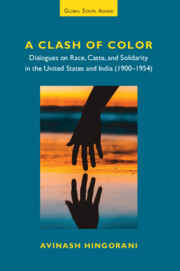 A Clash of Color
A Clash of Color Book contents
- Frontmatter
- Dedication
- Contents
- Acknowledgments
- Prologue
- Introduction
- 1 Rabindranath Tagore in America: Ideas and Impact
- 2 Lala Har Dayal, Taraknath Das, and the Ghadar Party
- 3 Lala Lajpat Rai and W. E. B. Du Bois
- 4 Lala Lajpat Rai in India
- 5 W. E. B. Du Bois and the Indian Independence Movement
- 6 W. E. B. Du Bois, Walter White, and B. R. Ambedkar’s Quest to Address Race, Caste, and Class
- Epilogue
- Bibliography
- Index
2 - Lala Har Dayal, Taraknath Das, and the Ghadar Party
Published online by Cambridge University Press: 28 November 2024
- Frontmatter
- Dedication
- Contents
- Acknowledgments
- Prologue
- Introduction
- 1 Rabindranath Tagore in America: Ideas and Impact
- 2 Lala Har Dayal, Taraknath Das, and the Ghadar Party
- 3 Lala Lajpat Rai and W. E. B. Du Bois
- 4 Lala Lajpat Rai in India
- 5 W. E. B. Du Bois and the Indian Independence Movement
- 6 W. E. B. Du Bois, Walter White, and B. R. Ambedkar’s Quest to Address Race, Caste, and Class
- Epilogue
- Bibliography
- Index
Summary
By the 1910s, the Indian independence movement was well under way. Intellectuals such as Rabindranath Tagore, apprehensive about drawing scrutiny from the British government, hesitated to use the US as a base for actively spreading Indian independence propaganda. However, Indians such as Lala Har Dayal and Taraknath Das rejected such qualms as they sought to build an internationalist coalition to fight against White supremacy and colonialism. The center of this coalition was the Ghadar Party, a political organization created by Har Dayal and other Indian revolutionaries such as Sant Baba Wasakha Singh Dadehar, Baba Jawala Singh, Santokh Singh, and Sohan Singh Bhakna in 1913 in Astoria, Oregon. Mark Naidis argues that the Ghadar Party built alliances with the Irish independence movement and was primarily a promoter of Indian nationalism, seeking only to liberate India from the British. However, the party also had a platform of global decolonization and establishing democracy for all colonized peoples was one of their goals.
The Ghadar Party operated primarily along the West Coast, in states such as California and Washington due to the larger Indian population in the region, and as a result it did not reach many Black or Indigenous Americans, who lived in other areas of the US. Similarly, Ghadar Party members did not actively try to enlist Black Americans, focusing instead on the anti-colonial and self-determination struggles of subjects of European colonization. Lala Har Dayal, however, did compare the Black American experience to the situation of Indians under British colonialism, and theorized that American racism mirrored caste discrimination in India. Other Ghadar Party members such as Das and Ram Chandra believed that the condition of Indians under British rule was akin to the experience of Black slaves in the US prior to the Civil War. However, the party as a whole did not see the plight of Black Americans in the early twentieth century as a direct parallel to their own struggle in India, and they did not believe that the Black American struggle was one of self-determination. That outlook, and the fact that Har Dayal only led the Ghadar Party until 1914, may offer an additional explanation as to why the organization did not foster solidarity with African Americans.
- Type
- Chapter
- Information
- A Clash of ColorDialogues on Race, Caste, and Solidarity in the United States and India (1900–1954), pp. 46 - 62Publisher: Cambridge University PressPrint publication year: 2025
